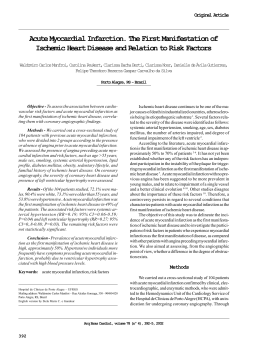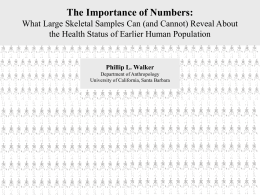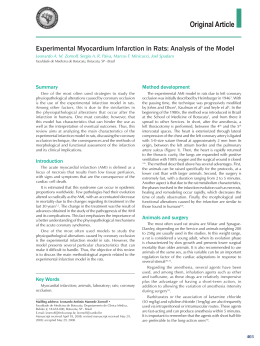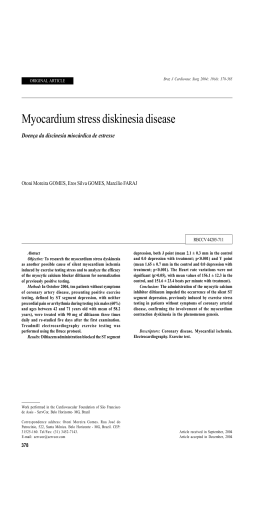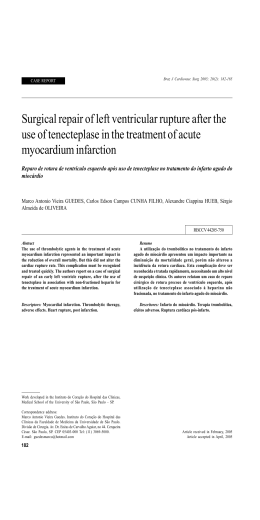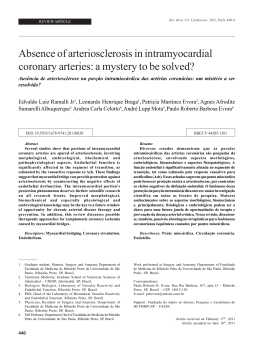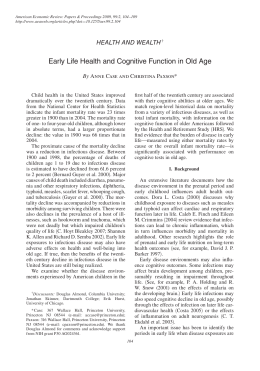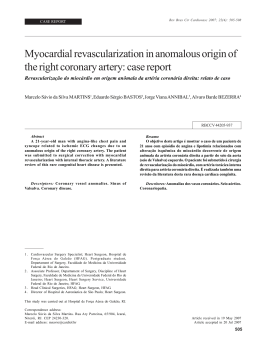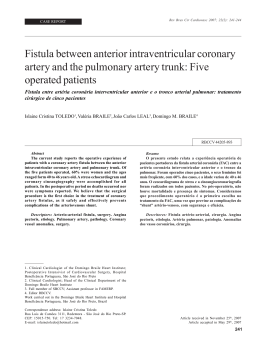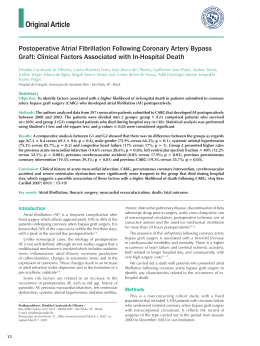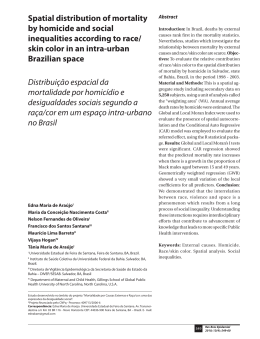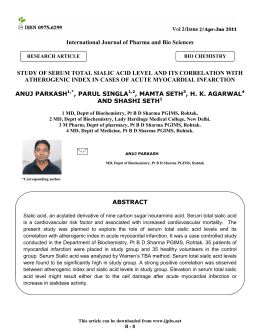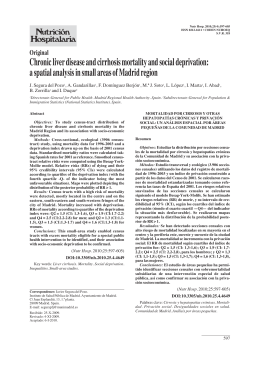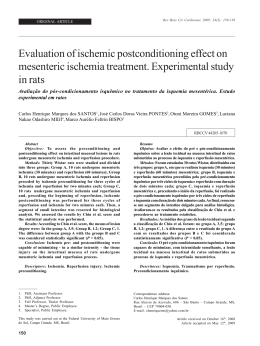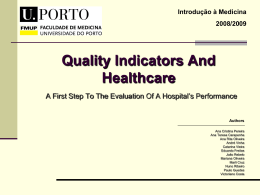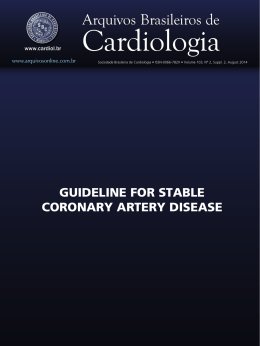ORIGINAL CONTRIBUTION ONLINE FIRST Association of Changes in Clinical Characteristics and Management With Improvement in Survival Among Patients With ST-Elevation Myocardial Infarction Etienne Puymirat, MD Tabassome Simon, MD, PhD Philippe Gabriel Steg, MD François Schiele, MD, PhD Pascal Guéret, MD, PhD Didier Blanchard, MD Khalife Khalife, MD Patrick Goldstein, MD Simon Cattan, MD Laurent Vaur, MD Jean-Pierre Cambou, MD Jean Ferrières, MD, PhD Nicolas Danchin, MD, PhD For the USIK USIC 2000 and FAST MI Investigators S EVERAL SOURCES , INCLUDING registries specific to acute myocardial infarction (AMI) and large administrative or billing databases, have shown a decrease in mortality in patients with ST-segment elevation myocardial infarction (STEMI) over the past 10 to 15 years.1-9 This decline is usually attributed to increased use and improved delivery of reperfusion therapy, in particular primary percutaneous coronary intervention (PCI). We hypothesized that, beyond primary PCI, other factors such as temporal changes in patient population characteristics may account for part of the observed reduction in mortality of patients with STEMI. The aim of the present study was to assess the association between changes Context The contemporary decline in mortality reported in patients with STsegment elevation myocardial infarction (STEMI) has been attributed mainly to improved use of reperfusion therapy. Objective To determine potential factors—beyond reperfusion therapy— associated with improved survival in patients with STEMI over a 15-year period. Design, Setting, and Patients Four 1-month French nationwide registries, conducted 5 years apart (between 1995, 2000, 2005, 2010), including a total of 6707 STEMI patients admitted to intensive care or coronary care units. Main Outcome Measures Changes over time in crude 30-day mortality, and mortality standardized to the 2010 population characteristics. Results Mean (SD) age decreased from 66.2 (14.0) to 63.3 (14.5) years, with a concomitant decline in history of cardiovascular events and comorbidities. The proportion of younger patients increased, particularly in women younger than 60 years (from 11.8% to 25.5%), in whom prevalence of current smoking (37.3% to 73.1%) and obesity (17.6% to 27.1%) increased. Time from symptom onset to hospital admission decreased, with a shorter time from onset to first call, and broader use of mobile intensive care units. Reperfusion therapy increased from 49.4% to 74.7%, driven by primary percutaneous coronary intervention (11.9% to 60.8%). Early use of recommended medications increased, particularly lowmolecular-weight heparins and statins. Crude 30-day mortality decreased from 13.7% (95% CI, 12.0-15.4) to 4.4% (95% CI, 3.5-5.4), whereas standardized mortality decreased from 11.3% (95% CI, 9.5-13.2) to 4.4% (95% CI, 3.5-5.4). Multivariable analysis showed a consistent reduction in mortality from 1995 to 2010 after controlling for clinical characteristics in addition to the initial population risk score and use of reperfusion therapy, with odds mortality ratios of 0.39 (95%, 0.29-0.53, P⬍.001) in 2010 compared with 1995. Conclusion In France, the overall rate of cardiovascular mortality among patients with STEMI decreased from 1995 to 2010, accompanied by an increase in the proportion of women younger than 60 years with STEMI, changes in other population characteristics, and greater use of reperfusion therapy and recommended medications. JAMA. 2012;308(10):doi:10.1001/2012.jama.11348 Author Affiliations: Assistance Publique-Hôpitaux de Paris (AP-HP), Hôpital Européen Georges Pompidou, Department of Cardiology, Université ParisDescartes, and INSERM U-970, Paris, France (Dr Puymirat); AP-HP, Hôpital Saint Antoine, Department of Clinical Pharmacology and Unité de Recherche Clinique (URCEST), Paris; Université Pierre et Marie Curie (UPMC-Paris 06), Paris (Dr Simon); AP-HP, Hôpital Bichat Paris and Université Paris-Diderot, Sorbonne Paris-Cité, Paris (Dr Steg); INSERM U-698, Paris (Dr Steg); University Hospital Jean Minjoz, Department of Cardiology, Besançon (Dr Schiele); University Hospital Henri Mondor, Department of Cardiology, Créteil (Dr Guéret); Clinique St Gatien, Tours (Dr Blanchard); Metz Regional Hospital, Department of Cardiology, ©2012 American Medical Association. All rights reserved. Downloaded From: http://jama.jamanetwork.com/ on 08/27/2012 www.jama.com Metz (Dr Khalife); Lille Regional University Hospital, Emergency Department, Lille (Dr Goldstein); Intercity Hospital Le Raincy-Montfermeil, Department of Cardiology, Montfermeil (Dr Cattan); Novo-Nordisk, Paris-La Défense (Dr Vaur); Toulouse Rangueil University Hospital, Department of Cardiology and UMR1027, INSERM, Toulouse (Drs Cambou and Ferrières); and Assistance Publique-Hôpitaux de Paris (APHP), Hôpital Européen Georges Pompidou, Department of Cardiology and Université Paris-Descartes, Paris (Dr Danchin). Corresponding Author: Nicolas Danchin, MD, PhD, Hôpital Européen Georges Pompidou, Department of Cardiology, 20 rue Leblanc, 75015 Paris, France (nicolas [email protected]). JAMA, Published online August 27, 2012 E1 CLINICAL MANAGEMENT CHANGES AND IMPROVED STEMI SURVIVAL in early mortality and patient management and risk profile by analyzing data from 4 sequential nationwide French surveys conducted between 1995 and 2010.10-13 METHODS Four nationwide French registries were conducted 5 years apart over a 15-year period (1995 to 2010): USIK 1995,10 USIC (Unité de Soins Intensifs Coronaires) 2000,11 FAST-MI (French Registry of Acute ST-Elevation or nonST-elevation Myocardial Infarction) 2005 (NCT00673036),12 and FAST-MI 2010 (NCT01237418).13 All 4 registries included patients with STEMI or non-STEMI admitted alive to a coronary care unit (CCU) or an intensive care unit (ICU) within 48 hours of symptom onset, during a specified 1-month period (November for 1995 and 2000 and between October and midNovember for 2005 and 2010). The methods used for these crosssectional registries with longitudinal follow-up have been described previously.10-14 Briefly, their primary objectives were to evaluate the characteristics, management, and outcomes of patients with AMI admitted to CCUs or ICUs, as seen in routine clinical practice, using a catchment broad enough to provide data representative of the entire country, with strong external validity. Patients were recruited consecutively from CCUs or ICUs during the 1-month periods. Participation in the study was offered to all institutions, including university teaching hospitals, general and regional hospitals, and private clinics with ICUs that received acute coronary syndromes (ACSs) emergencies. Physicians were instructed that the study should not affect clinical care or management. In each center, a physician was responsible for overseeing the registry and provided a full list of all patients admitted to the unit with suspected MI. Inclusion criteria were (1) adults aged 18 years or older; (2) patients admitted to a CCU or ICU within 48 hours of symptom onset for an AMI E2 characterized by increased troponin, creatine kinase (CK) or CK-MB, associated with at least 1 of the following elements: symptoms compatible with myocardial ischemia, appearance of pathologic Q waves, or ST-T changes compatible with myocardial ischemia (ST-segment elevation or depression, T-wave inversion); and (3) willingness to take part in the study. Patients who died very soon after admission and for whom cardiac markers were not measured were included if they had signs or symptoms associated with typical ST-segment changes. Exclusion criteria were (1) refusal to participate; (2) MI admission more than 48 hours after symptom onset; (3) iatrogenic MIs, defined as occurring within 48 hours of a therapeutic procedure (coronary artery bypass graft surgery, coronary angioplasty, or any other medical or surgical intervention); (4) ACS diagnosis invalidated in favor of another diagnosis; and (5) patients with unstable angina and no increase in cardiac biomarkers. For the present analysis, only patients presenting with persistent STsegment elevation or new Q waves were considered. For each of the surveys, the number of patients screened exceeded the number of patients included; the most common reasons for noninclusion in all 4 surveys were onset of chest pain more than 48 hours from admission, admission outside the survey time window, or diagnosis of AMI not retained (eFigure 1 available at at http: //www.jama.com). The study was conducted in accordance with the guidelines on good clinical practice and French law. The study protocol for the 1995 and 2000 registries were reviewed by the Committee for the Protection of Human Subjects in Biomedical Research of Nancy University hospital; the 2005 registry was reviewed by the Committee for the Protection of Human Subjects in Biomedical Research of Saint Antoine University Hospital (2005); and the protocol of the 2010 registry was reviewed and approved by the Committee for the Protection of JAMA, Published online August 27, 2012 Downloaded From: http://jama.jamanetwork.com/ on 08/27/2012 Human Subjects of Saint Louis University Hospital, Paris. Data file collection and storage were approved by the Commission Nationale Informatique et Liberté. All patients were informed of the nature and aims of the surveys and could request to be excluded; in addition, written consent was obtained for the 2005 and 2010 surveys. Data Collection Data on baseline characteristics, including demographics (age, sex, body mass index [BMI], calculated as weight in kilograms divided by height in meters squared), risk factors (hypertension, diabetes, current smoking, hypercholesterolemia, family history of coronary artery disease, obesity defined as ⱖ30 BMI), and medical history (MI, stroke, heart failure, peripheral artery disease), were collected as previously described.10-14 Information on the use of cardiac procedures, including use and of type of reperfusion therapy (primary PCI or fibrinolysis), use of medications (antiplatelet agents, diuretics, -blockers, angiotensin-converting enzyme [ACE] inhibitors and lipidlowering agents) in the first 48 hours (or first 5 days, for the 1995 survey) and at-hospital discharge was recorded. In 2000, 2005, and 2010, time from symptom onset to first call or medical contact, and time to reperfusion therapy were also recorded. Several additional variables such as previous PCI, coronary artery bypass graft surgery, or chronic renal failure were also collected in the most recent surveys. Clinical Outcomes Mortality was assessed at 30 days. Information on this outcome was obtained directly by the physician responsible for overseeing of the study at each center for the 1995 and 2000 surveys. For the 2005 and 2010 surveys, follow-up was centralized at the French Society of Cardiology and dedicated study coordinators contacted both physicians and patients, after checking the patients’ vital status in municipal registers. ©2012 American Medical Association. All rights reserved. CLINICAL MANAGEMENT CHANGES AND IMPROVED STEMI SURVIVAL Hashemzadeh M. Trends in the age adjusted mortality from acute ST segment elevation myocardial infarction in the United States (1988-2004) based on race, gender, infarct location and comorbidities. Am J Cardiol. 2009;104(8):1030-1034. 5. Rogers WJ, Frederick PD, Stoehr E, et al. Trends in presenting characteristics and hospital mortality among patients with ST elevation and non-ST elevation myocardial infarction in the National Registry of Myocardial Infarction from 1990 to 2006. Am Heart J. 2008; 156(6):1026-1034. 6. Stolt Steiger V, Goy JJ, Stauffer JC, et al; AMIS Plus Investigators. Significant decrease in in-hospital mortality and major adverse cardiac events in Swiss STEMI patients between 2000 and December 2007. Swiss Med Wkly. 2009;139(31-32):453-457. 7. Hardoon SL, Whincup PH, Lennon LT, Wannamethee SG, Capewell S, Morris RW. How much of the recent decline in the incidence of myocardial infarction in British men can be explained by changes in cardiovascular risk factors? evidence from a prospective populationbased study. Circulation. 2008;117(5):598-604. 8. Yeh RW, Sidney S, Chandra M, Sorel M, Selby JV, Go AS. Population trends in the incidence and outcomes of acute myocardial infarction. N Engl J Med. 2010;362(23):2155-2165. 9. Fox KA, Steg PG, Eagle KA, et al; GRACE Investigators. Decline in rates of death and heart fail- ure in acute coronary syndromes, 1999-2006. JAMA. 2007;297(17):1892-1900. 10. Danchin N, Vaur L, Genès N, et al. Management of acute myocardial infarction in intensive care units in 1995: a nationwide French survey of practice and early hospital results. J Am Coll Cardiol. 1997; 30(7):1598-1605. 11. Hanania G, Cambou JP, Guéret P, et al; USIC 2000 Investigators. Management and in-hospital outcome of patients with acute myocardial infarction admitted to intensive care units at the turn of the century: results from the French nationwide USIC 2000 registry. Heart. 2004;90(12):1404-1410. 12. Cambou JP, Simon T, Mulak G, Bataille V, Danchin N. The French registry of Acute ST elevation or nonST-elevation Myocardial Infarction (FAST-MI): study design and baseline characteristics. Arch Mal Coeur Vaiss. 2007;100(6-7):524-534. 13. Hanssen M, Cottin Y, Khalife K, et al; FAST-MI 2010 Investigators. French Registry on Acute STelevation and non ST-elevation Myocardial Infarction 2010: FAST-MI 2010. Heart. 2012;98(9):699705. 14. Danchin N, Vaur L, Genès N, et al. Treatment of acute myocardial infarction by primary coronary angioplasty or intravenous thrombolysis in the “real world”: one-year results from a nationwide French survey. Circulation. 1999;99(20):2639-2644. ©2012 American Medical Association. All rights reserved. Downloaded From: http://jama.jamanetwork.com/ on 08/27/2012 15. Gale CP, Manda SO, Weston CF, Birkhead JS, Batin PD, Hall AS. Evaluation of risk scores for risk stratification of acute coronary syndromes in the Myocardial Infarction National Audit Project (MINAP) database. Heart. 2009;95(3):221-227. 16. Schiele F, Hochadel M, Tubaro M, et al. Reperfusion strategy in Europe: temporal trends in performance measures for reperfusion therapy in STelevation myocardial infarction. Eur Heart J. 2010; 31(21):2614-2624. 17. Wagner A, Ruidavets J, Montave M, et al. Trends in coronary heart disease in France from 2000 to 2007. BEH. 2011;40-41:414-419. 18. Berry JD, Dyer A, Cai X, et al. Lifetime risks of cardiovascular disease. N Engl J Med. 2012;366(4): 321-329. 19. Beck F, Guignard R, Richard J, Wilquin J, Perreti-Watel P. Increasing trends in smoking in France: main results of the French Health Barometer, France 2010. BEH. 2011;20-21:230-233. 20. Ford ES, Greenlund KJ, Hong Y. Ideal cardiovascular health and mortality from all causes and diseases of the circulatory system among adults in the United States. Circulation. 2012;125(8):987-995. 21. Ford ES, Ajani UA, Croft JB, et al. Explaining the decrease in U.S. deaths from coronary disease, 1980-2000. N Engl J Med. 2007;356(23):23882398. JAMA, Published online August 27, 2012 E9 CLINICAL MANAGEMENT CHANGES AND IMPROVED STEMI SURVIVAL Patient Admission Pathways Median time from symptom onset to hospital admission decreased from 240 minutes (interquartile range [IQR], 140-540 minutes) to 175 minutes (IQR, 107-380 minutes), as did the median time from onset to first call from 120 minutes (IQR, 41-360 minutes) in 2000 to 74 minutes (IQR, 30-240 minutes) in 2010, whereas the use of mobile intensive care units increased from 23.2% to 48.8% (percentage change, 25.6% [95% CI, 22.5%-28.6%]; TABLE 2). The percentage of admissions to community hospitals decreased from 60.2% to 44.0% (percentage change, −16.2% [95% CI, −12.8% to −19.6%]), together with a decrease in the number of participating institutions, in keeping with the health authorities’ recommendation to reduce the number of institutions providing care for STEMI patients from 501 in 1995 to 279 in 2010. Across surveys, the mean (SD) number of patients per center increased from 5.7 (3.6) to 8.7 (8.0). Table 1. Baseline Characteristics of Patients With ST-Segment Elevation Myocardial Infarction From 1995 to 2010 Clinical Characteristics Age, mean (SD), y 1995 (n = 1536) 2000 (n = 1844) 2005 (n = 1611) 66.2 (14.0) 64.5 (14.6) 64.0 (14.7) 2010 (n = 1716) 63.3 (14.5) P for Trend Percentage Change From 1995 to 2010, (95% CI) ⬍.001 −2.9 (−1.9 to −3.9) ⬍.001 −8.9 (−5.0 to −12.8) Men ⬍60 421 (38.1) 622 (46.3) 585 (50.7) 634 (49.0) 60-74 457 (41.4) 455 (33.9) 353 (30.6) 420 (32.5) ⱖ75 227 (20.5) 267 (19.9) 215 (18.6) 239 (18.5) Women ⬍60 60-74 ⱖ75 Women, No. (%) BMI, mean (SD) No. of patients 51 (11.8) 87 (17.4) 107 (23.4) 108 (25.5) 148 (34.3) 166 (33.2) 121 (26.4) 117 (27.7) 232 (53.8) 247 (49.4) 230 (50.2) 198 (46.8) 431 (28.1) 500 (27.1) 458 (28.4) 423 (24.7) 25.9 (3.9) 26.3 (4.1) 26.9 (4.6) 26.7 (4.4) 1454 1654 1440 1615 Type of institution University hospital 380 (25) 518 (28) 609 (38) 634 (37) Community/Army hospital 925 (60) 972 (53) 751 (47) 755 (44) Private clinic 231 (15) 354 (19) 251 (16) 327 (19) 5.1 (3.6) 5.8 (5.6) 7.6 (7.1) 8.7 (8.0) Number of patients per center, per mo, mean (SD) Risk factors, No. (%) Hypertension 10.9 (7.0 to 14.8) −2.1 (1.1 to −5.3) 13.7 (8.5 to 18.8) ⬍.001 −6.7 (−0.05 to −12.8) −7.0 (−0.03 to −13.6) .06 −3.4 (−0.4 to −6.4) ⬍.001 0.8 (0.5 to 1.1) 12.2 (9.0 to 15.3) ⬍.001 −16.2 (−12.8 to −19.6) 4.0 (1.4 to 6.6) ⬍.001 3.6 (3.4 to 3.8) 673 (43.8) 804 (43.6) 792 (49.2) 806 (47.0) .006 3.1 (−0.03 to 6.6) Hypercholesterolemia 534 (34.8) 719 (39.0) 699 (43.4) 675 (39.3) .001 4.6 (1.2 to 7.9) Diabetes mellitus 242 (15.8) 364 (19.7) 302 (18.7) 283 (16.5) .92 0.7 (−1.8 to 3.3) Current smoking 491 (32.0) 651 (35.3) 600 (37.2) 701 (40.9) ⬍.001 8.9 (5.6 to 12.2) Obesity 208 (14.3) 269 (16.3) 299 (20.8) 324 (20.1) ⬍.001 5.8 (3.1 to 8.4) Cardiovascular history, No. (%) Myocardial infarction 225 (14.6) 276 (15.0) 180 (11.2) 187 (10.9) ⬍.001 −3.7 (−1.5 to −6.1) Stroke or TIA 96 (6.2) 78 (4.2) 91 (5.6) 68 (4.0) ⬍.001 −2.3 (−0.08 to −3.8) Heart failure 98 (6.4) 84 (4.6) 56 (3.5) 41 (2.4) ⬍.001 −4.0 (−2.6 to −5.5) 148 (9.7) 145 (7.9) 85 (5.3) 83 (4.8) ⬍.001 −4.8 (−3.0 to −6.6) 139 (7.5) 140 (8.7) 175 (10.2) 50 (2.7) 34 (2.1) 96 (5.6) ⬍.001 66 (3.62) .15 Peripheral artery disease PCI CABG surgery Comorbidity Chronic kidney disease .005 50 (3.1) 42 (2.1) COPD 47 (2.7) 85 (5.0) .003 Cancer 100 (6.2) 147 (8.6) .01 389 (21.1) 336 (20.9) 335 (19.5) .25 304 (16.5) 342 (21.2) 374 (21.8) ⬍.001 Medications before, No. (%) Antiplatelet therapy Statin −Blocker 338 (18.3) 296 (18.4) 313 (18.2) .95 ACE−I or ARB 349 (18.9) 395 (24.5) 478 (27.9) ⬍.001 Abbreviations: ACE-I, angiotensin-converting enzyme inhibitor; ARB, angiotensin receptor blocker; blank cells, data not available; BMI, body mass index, which is calculated as weight in kilograms divided by height in meters squared; CABG, coronary artery bypass graft; COPD, chronic obstructive pulmonary disease; IQR, interquartile range; PCI, percutaneous coronary intervention; TIA, transient ischemic attack. E4 JAMA, Published online August 27, 2012 Downloaded From: http://jama.jamanetwork.com/ on 08/27/2012 ©2012 American Medical Association. All rights reserved. CLINICAL MANAGEMENT CHANGES AND IMPROVED STEMI SURVIVAL Hospital Management The use of reperfusion therapy increased over time, from 49.4% to 74.7% (percentage change, 25.2% [95% CI, 22.0% to 28.4%]) with more frequent use of primary PCI, (11.9% to 60.8%; (percentage change, 48.9% [95% CI, 46.0% to 51.6%]) and less frequent use of fibrinolysis (37.5% to 13.9%; percentage change, −23.6% [95% CI, −20.7% to −26.5%]; Table 2). Use of coronary angiography at any time during the index admission increased, to reach 96.3% in 2010, whereas the rate of hospital PCI, increased from 19.5% to 86.7% (percentage change, 67.2% [95% CI, 64.5% to 69.6%]). The use of evidence-based treatments during the first 48 hours from admission increased gradually over the 15- year period. Early use of -blockers increased from 65.2% to 80.7%; (percentage change, 15.5% [95% CI, 12.4% to 18.5%]), ACE inhibitors or angiotensin-receptor blockers from 47.7% to 64.8% (percentage change, 17.1% [95% CI, 13.7% to 20.4%]), and statins from 9.8% to 89.9% (percentage change, 80.1% [95% CI, 77.9% to 82.0%]; all P for trend ⬍.001). Likewise, antithrombotic medications used during the first 48 hours of admission changed markedly, with increasing early use of antiplatelet agents from 92.4% to 97.4% (percentage change, 5.0% [95% CI, 3.6% to 6.6%]) intravenous glycoprotein IIb/ IIIa inhibitors from 19.0% in 2000 to 42.7% in 2010 (percentage change, 23.6% [95% CI, 20.6% to 26.5%]), and low-molecular-weight heparins from 27.4% in 2000 to 62.3% in 2010 (percentage change, 34.9% [95% CI, 31.7 to 37.9%]), whereas the use of unfractionated heparin decreased from 96.4% to 44.8% (percentage change, −51.7% [95% CI, −49.1% to −54.1%]; all P for trend ⬍.001). The speed of implementation of recommended treatments, reperfusion therapy, or both over the study period was similar across regions and hospital types, although the change in use of primary PCI, was more marked in patients admitted to community hospitals. Proportionally, the use of primary PCI, increased to a greater extent in patients 75 years or older from 5.4% to 54.0% (percentage change, 48.6% [95% CI, 43.1% to 53.6%]) than among patients younger than 60 years, from Table 2. Early Hospital Management of Patients With ST-Segment Elevation Myocardial Infarction From 1995 to 2010 Clinical Characteristics 1995 a (n = 1536) 2000 (n = 1844) Initial pathway: mobile ICU, No. (%) 427 (23.2) Time delay, median (IQR), min Symptom onset to first call/medical contact 120 (41 to 360) No. of patients Symptom onset to admission No. of patients Anterior wall MI Peak creatine kinase, U/L Mean (SD) 1486 240 (140 to 540) 1427 636 (41.4) 255 (150 to 540) 1706 666 (41.3) 90 (30 to 295) 1600 200 (120 to 430) 1610 2010 (n = 1716) 837 (48.8) 74 (30 to 240) 1674 175 (107 to 380) 1628 (1881) .50 −36 (−166 to 94) 1527 1832 993 (362-2775) 1437 985 (370-2218) 1366 777 (50.6) 870 (47.2) 591 (36.7) 435 (25.3) Fibrinolysis 576 (37.5) 545 (29.6) 465 (28.9) 238 (13.9) Primary PCI 183 (11.9) 429 (23.3) 555 (34.5) 1043 (60.8) −23.6 (−20.7 to −26.5) 48.9 (46.0 to 51.6) 1489 (80.7) 1449 (89.9) 1642 (96.3) ⬍.001 1132 (61.4) 1221 (75.8) 1488 (86.7) ⬍.001 67.2 (64.5 to 69.6) 1419 (92.4) 1759 (95.4) 1544 (95.8) 1672 (97.4) ⬍.001 5.0 (3.6 to 6.6) 1415 (87.8) 1646 (95.9) ⬍.001 Gp IIb/IIIa inhibitor 1481 (96.4) LMWH ACE−I or ARB −25.2 (−21.9 to −28.5) ⬍.001 300 (19.5) Thienopyridine −Blocker −62 (−28.7 to −95.3) 1654 (1946) No. of patients Statin ⬍.001 1698 −3.1 (.03 to −6.5) 1722 (1780) Unfractionated heparin ⬍.001 .07 1209 (600-2175) Medications in first 48 h, No. (%) b Antiplatelet therapy ⬍.001 648 (38) 1664 (1671) PCI Percentage Change From 1995 to 2010, (95% CI) 647 (40.2) 1200 (608-2112) Procedures during hospitalization, No. (%) Coronary angiography P for Trend 746 (40.5) Median (IQR) Reperfusion therapy, No. (%) None 2005 (n = 1611) 351 (19.0) 595 (36.9) 732 (42.7) ⬍.001 1463 (79.3) 715 (44.4) 768 (44.8) ⬍.001 506 (27.4) 924 (57.4) 1069 (62.3) ⬍.001 −51.7 (−49.1 to −54.1) 151 (9.8) 842 (45.7) 1262 (78.3) 1543 (89.9) ⬍.001 80.1 (77.9 to 82.0) 1001 (65.2) 1348 (73.1) 1162 (72.1) 1384 (80.7) ⬍.001 15.5 (12.4 to 18.5) 733 (47.7) 764 (41.4) 853 (52.9) 1112 (64.8) ⬍.001 17.1 (13.7 to 20.4) Abbreviations: ACE-I, angiotensin-converting enzyme inhibitor; ARB, angiotensin receptor blocker; Gp, glycoprotein; ICU, intensive care unit; IQR, interquartile range; LMWH, lowmolecular-weight heparin; MI, myocardial infarction; PCI, percutaneous coronary intervention. a For 1995, blank cells indicate data not available. b For 1995, medications used at any time during the first 5 days. ©2012 American Medical Association. All rights reserved. Downloaded From: http://jama.jamanetwork.com/ on 08/27/2012 JAMA, Published online August 27, 2012 E5 CLINICAL MANAGEMENT CHANGES AND IMPROVED STEMI SURVIVAL Table 3. Observed and Risk Score-Standardized 30-Day Mortality Rates 1536 1844 Observed 13.7 (12.0-15.4) 8.7 (7.4-10.0) Standardized 11.3 (9.5-13.2) 7.6 (5.7-9.5) Multivariable Logistic Regression Analyses, OR (95% CI) a 1 [Reference] 0.64 (0.51-0.81) 1611 1716 6.9 (5.7-8.2) 4.4 (3.5-5.4) 6.4 (5.1-7.7) 4.4 (3.5-5.4) 0.52 (0.40-0.68) 0.39 (0.29-0.53) 30−Day Mortality, % (95% CI) Year No. of Events No. of Patients 1995 2000 210 160 2005 2010 111 75 P Value .001 .001 .001 a Adjusted for patient risk profile, infarct location, region, type of institution and reperfusion therapy. 15.9% to 64.0% (percentage change, 48.1% [95% CI, 43.0% to 52.8%]), with little difference according to sex. Outcomes Thirty-day mortality decreased from 13.7% in 1995 to 4.4% in 2010 (TABLE 3) In multivariable logistic regression analyses, compared with 1995, the risk of death was lower in 2000 (OR, 0.64 [95% CI, 0.51-0.81]; P⬍.001) than in 2005 (OR, 0.52 [95% CI, 040-0.68] P⬍.001) and in 2010 (OR, 0.39 [95% CI, 0.29-0.53]; P⬍.001). Mortality decreased irrespective of use and type of reperfusion therapy, including among patients who did not receive any reperfusion therapy: no reperfusion (18.9% to 8.7%; adjusted OR. 0.47 [95% CI, 0.32-0.70), fibrinolysis (8.2% to 2.1%; adjusted OR, 0.29 [95% CI, 0.110.76]), primary PCI, (8.7% to 3.2%; adjusted OR, 0.29 [95% CI, 0.15-0.58]; FIGURE). Likewise, mortality decreased consistently regardless of age, sex, or patient risk level (eFigure 3). In particular comparing 1995 to 2010, mortality decreased from 9.8% to 2.6% in men (adjusted OR, 0.30 [95% CI, 0.200.46]) and from 23.7% to 9.8% in women (adjusted OR, 0.48 [95% CI, 0.32-0.74]). Likewise, the decrease in mortality was consistent in the centers participating in all surveys (8.3% in 2000, 6.6% in 2005, and 4.6% in 2010; P⬍.001), and in those who had not participated in all surveys (9.1% in 2000, 7.6% in 2005, and 4.1% in 2010, P =.001). Mortality from 1995 to 2010 declined in both academic centers (9.2% in 1995 to 4.7% in 2010) or community hospitals (15.5% to 5.5%), and type E6 of institution was not an independent correlate of 30-day mortality in multivariate analyses. In addition, examination of early vs later deaths revealed consistent findings. Deaths within 48 hours were 4.0% in 1995, 3.7% in 2000, 2.0% in 2005, and 1.5% in 2010 (P for trend ⬍.001), whereas deaths from 48 hours to 30 days were 10.1% in 1995, 5.2% in 2000, 5.0% in 2005, and 3.0% in 2010 (P for trend ⬍.001). When death rates were standardized for the 2010 risk score (representing the expected rates, standardized on the risk distribution profile of 2010), mortality decreased gradually over time: 11.3% in 1995, 7.6% in 2000, 6.4% in 2005, and 4.4% in 2010. Adding total CK as a covariate in the model yielded similar results when comparing ORs against 1995: 0.62 (95% CI, 0.490.80) in 2000; 0.55 (95% CI, 0.410.72) in 2005; and 0.37 (95% CI, 0.260.53) in 2010. Consistent with the decrease in mortality, all major hospital complications of STEMI also decreased over time: cardiogenic shock, 7.4% to 4.7% (adjusted OR, 0.66 [95% CI, 0.480.92]); recurrent myocardial infarction, 2.6% in 2000 to 1.0% (adjusted OR, 0.51 [95% CI, 0.29-0.90]); ventricular fibrillation or cardiac arrest, 4.2% to 2.7% (adjusted OR, 0.68 [95% CI, 0.46-1.01]); atrial fibrillation, 12.5% to 5.6% (adjusted OR, 0.46 [95% CI, 0.36-0.60]); and atrioventricular block, 7.8% to 2.6% (adjusted OR, 0.32 [95% CI, 0.22-0.45]). Bleeding complications were recorded from 2005; investigator-reported major bleeding decreased from 1.9% in 2005 to 0.8% in 2010; transfusion rates, however, remained unchanged. JAMA, Published online August 27, 2012 Downloaded From: http://jama.jamanetwork.com/ on 08/27/2012 COMMENT The main findings of this study are that 30-day STEMI mortality decreased by approximately 9%, a decrease of 68% in 15 years, and although this reduction parallels improvements in care, such as greater use of primary PCI, and adjunctive therapies, it was also associated with a substantial change in the patient risk profile. Specifically, the absolute 30-day mortality decreased from 9.3% (observed) to 6.9% (standardized), attesting a 26% reduction related to the changes in patient risk profile. Within the STEMI population targeted by these sequential registries, the relative proportion of older patients has decreased, while the proportion of younger men and the proportion and numbers of younger women have increased. These observations suggest that future reductions in the incidence and mortality related to AMI will need specific targeting of preventive measures toward younger women and possibly younger men. The progressive decline in early mortality over time observed in the present nationwide surveys is consistent with many other sources in the United States1,3-5 and Europe.2,6,7,16 This change is explained largely by major improvements in the delivery of care for AMI, including the more frequent implementation of reperfusion therapy, the more frequent use of primary PCI, as a reperfusion method, and use of potent adjunctive evidence-based therapies (including antithrombotic agents, statins, -blockers, and ACE inhibitors or angiotensin-receptor blockers). It may also be related to changes in patient behavior, such as faster calls for medical assistance after symptom onset and more ©2012 American Medical Association. All rights reserved. CLINICAL MANAGEMENT CHANGES AND IMPROVED STEMI SURVIVAL Figure. Changes in 30-Day Mortality According to Use and Type of Reperfusion Therapy 25 1995 2000 2005 2010 20 30-Day Mortality, % frequent use of the prehospital mobile intensive care system, as well as changes in the general organization of care for STEMI patients, with the concentration of care provision in a smaller number of institutions, treating larger numbers of patients. In this regard, it must be noted that French health authorities have launched several media campaigns in the past 10 years to increase public awareness of the initial symptoms of heart attacks and to encourage the use of the national emergency telephone number. Attesting that the changes in early mortality went well beyond the broader use of primary PCI and reperfusion therapy, we observed that the risk of death within the groups receiving reperfusion by primary PCI or by fibrinolysis also decreased considerably. Associated with these changes in patient behavior and physician management, during this 15-year period profound changes in the characteristics of the AMI population occurred, with presentation at a younger age, particularly in women. As expected, the lower age was associated with a reduction in the prevalence of comorbidities and history of cardiovascular disease. The increased proportion of younger patients was mainly at the expense of a reduction in the proportion of patients aged 60 to 74 years—from 39.3% to 31.3%, whereas the proportion of 75 years or older of age was less affected— from 30.0% to 25.5%. Overall, while the catchment area of the sequential registries may have varied somewhat, which may account for some changes in patient age and sex, the absolute numbers of patients 65 years or older has substantially decreased. This decrease was all the more striking considering that the French population got older from 1995 to 2010. In fact, the decrease in the number of older patients with STEMI in the subsequent years of the registry is consistent with population-based epidemiological data showing a progressive decrease in the average age of patients hospitalized with AMI, both in France17 and in other countries.2 15 10 5 0 No. of patients No Reperfusion Fibrinolysis Primary Percutaneous Coronary Intervention 777 870 591 435 576 545 465 238 183 429 555 1043 The adjusted odds ratios comparing 1995 with 2010 are 0.47 (95% CI, 0.32-0.70) for those who received no perfusion, 0.29 (95% CI, 0.11-0.76) for those who received fibrinolysis treatment, and 0.29 (95% CI, 0.150.58) for those who received percutaneous coronary intervention. As the relationship of prevention strategies with cardiovascular events and death rates has been conclusively demonstrated,18 the age decrease in STEMI patients can be hypothesized to result from the efficacy of primary prevention in patients with recognized, treatable risk factors such as hypercholesterolemia, hypertension, or diabetes and may result from the decrease in smoking among older individuals in France. Concordant with our results, the incidence of hospitalized AMI cases has been decreasing by about 2.5% per year in recent years, both in France (Christine De Peretti, MD, Institut National de Veille Sanitaire, written communication, August 2, 2012), in the United States,8 and in other countries.7 In a nationwide population-based study in France, the decrease in the incidence of AMI was most evident in both men and women who were older than 65 years, while it was less marked in younger men, and the reverse trend (ie, increased incidence) was observed for younger women (De Peretti, written communication). Likewise, in our registries, even though STEMI in women mostly affected older patients, the relative proportion of women younger than 50 years hospitalized for STEMI has increased considerably from 3.7% to 11.1%). These observations are consistent with the increase in current smok- ©2012 American Medical Association. All rights reserved. Downloaded From: http://jama.jamanetwork.com/ on 08/27/2012 ing among younger women during the past 30 years in France.19 The greater proportional increase in primary PCI, in elderly patients was somewhat unexpected; it might be related to the fact that younger patients may have less obstructive disease and more thrombosis. The greater magnitude of mortality decrease in community hospitals, compared with academic institutions, might be explained by a shift of more severe patients, formerly treated in community hospitals and now preferentially referred to academic centers, and by the closure or regrouping of smaller hospitals, with less experience in treating STEMI patients. Limitations As in any observational study, there are limitations to our analysis. None of the registries considered was populationbased, and their catchment areas may have changed slightly over time, although every effort was made in each survey to capture the greatest possible proportion of centers participating in the care of STEMI patients in the entire country. The total number of such sites did change over 15 years, as a consequence of deliberate health policy planning that tried to avoid referral of STEMI patients to small nonspecialized centers. JAMA, Published online August 27, 2012 E7 CLINICAL MANAGEMENT CHANGES AND IMPROVED STEMI SURVIVAL Patients were included during the months of October or November, so we therefore have no means to detect possible temporal trends in seasonal variations. Also, we did not record specific contraindications to any medication; this may have influenced the rate of use of certain medications, and may have been an unrecognized confounder, but we would not expect the prevalence of contraindications to specific therapies, particularly antithrombotic therapies to change markedly. If anything, the modest decrease in age would be expected to be associated with a modest reduction in contraindications. Because the criterion for enrollment was admission to a CCU or ICU, changes over time in admission policy and changes in risk of prehospital sudden death may also have affected the type and number of patients eligible for enrollment. Also, we cannot exclude that a very small number of patients might have died of other conditions such as aortic dissection, with STelevation on their electrocardiographs, before any imaging technique could be performed. Owing to the lack of certain variables in the first registries, we could not use well-validated scores such as the Global Registry on Acute Coronary Events (GRACE) or Thrombolysis In Myocardial Infarction (TIMI) scores to compare the baseline risks of the populations. We therefore used an internally derived multivariable model to predict death and categorize patient risk, which yielded adequate discriminating power (C statistic, 0.75); also, sensitivity analyses performed using 2 well-validated risk scores yielded identical results. Although we hypothesize that the reduction in the proportion of older patients with STEMI was related to the efficacy of prevention, we cannot within the scope of this study document such an effect, but our findings are consistent with observations suggesting that the reduction in cardiovascular mortality observed in recent years in North America and Western Europe is a consequence of successful E8 prevention efforts at least as much as a consequence of improved curative treatments.20,21 CONCLUSIONS In France, the overall rate of cardiovascular events and mortality in patients hospitalized with STEMI has decreased from 1995 to 2010. This was accompanied by an increase in the proportion of younger women and changes in population characteristics, a reduction in the number of institutions providing care for STEMI patients together with an increased use of recommended therapeutic measures, and changes in patients’ behavior when confronted with symptoms of infarction. Published Online: August 27, 2012. doi:10.1001 /2012.jama.11348 Author Contributions: Dr Danchin had full access to all of the data in the study and takes responsibility for the integrity of the data and the accuracy of the data analysis. Study concept and design: Puymirat, Simon, Steg, Danchin. Acquisition of data: Steg, Schiele, Guéret, Blanchard, Khalife, Goldstein, Cattan, Vaur, Cambou, Ferrières, Danchin. Analysis and interpretation of data: Puymirat, Simon, Steg, Danchin. Drafting of the manuscript: Puymirat, Simon, Steg, Danchin. Critical revision of the manuscript for important intellectual content: Schiele, Guéret, Blanchard, Khalife, Goldstein, Cattan, Vaur, Cambou, Ferrières. Statistical analysis: Puymirat, Danchin. Obtained funding: Simon, Danchin. Administrative, technical, or material support: Guéret, Cattan, Ferrières, Danchin. Study supervision: Simon, Cambou, Danchin. Conflict of Interest Disclosures: All authors have completed and submitted the ICMJE Form for Disclosure of Potential Conflicts of Interest. Dr Simon reported receiving research grants: Astra-Zeneca, Daiichi-Sankyo, Eli-Lilly, Glaxo-Smith-Kline, MSD, Novartis, Pfizer, sanofi-aventis, and Servier and speaker and consulting fees: AstraZeneca, BayerSchering, Eli-Lilly, and sanofi-aventis. Dr Steg reported receiving institutional research grant support: NYU School of Medicine, sanofi-aventis, and Servier; Consulting/advisory board fees: Ablynx, Amarin, Astellas, AstraZeneca, Bayer, BoehringerIngelheim, BMS, Daiichi-Sankyo-Lilly, GSK, Medtronic, MSD, Novartis, Otsuka, Pfizer, Roche, sanofi-aventis, Servier, and The Medicines Company; and being a stockholder and co-founder: Aterovax. Dr Schiele reported receiving grant support to his institution and travel support for scientific meetings: AstraZeneca, Boehringer-Ingelheim, Daiichi–Sankyo, Lilly, Medtronic, Pfizer; sanofiaventis, Servier, and Takeda. Dr Guéret reported receiving research grants: Toshiba and General Electric Systems and consulting and speaker’s fees: Boehringer-Ingelheim, Daiichi-Sankyo, Eli-Lilly, General Electric Systems, Ipsen, Pfizer, sanofiaventis, and Servier. Dr Goldstein reported speaker, board membership, and consulting fees: BoeringerIngelheim, The Medicines Company, sanofi-aventis, JAMA, Published online August 27, 2012 Downloaded From: http://jama.jamanetwork.com/ on 08/27/2012 BMS, AstraZeneca, Bayer, and Lilly Daiichi Sankyo. Dr Cattan reported receiving grants: AstraZeneca, Boehringer Ingelheim, Boston Scientific, Medtronic, and Servier. Dr Vaur reported being a former fulltime employee of Roussel and Aventis-France and being currently employed at Novo-Nordisk. Dr Ferrières reported receiving grants and speaker fees: AstraZeneca, Genzyme, Merck, Novartis, and Servier. Dr Danchin reported receiving research grants: AstraZeneca, Daiichi-Sankyo, Eli-Lilly, Glaxo-Smith-Kline, MSD, Novartis, Pfizer, sanofiaventis, Servier, and The Medicines Company and advisory panels or lecture fees: AstraZeneca, Boehringer-Ingelheim, Bristol-Myers Squibb, EliLilly, Menarini, Merck-Serono, Novo-Nordisk, Servier, and sanofi-aventis. Drs Puymirat, Blanchard, Khalife, and Cambou reported no conflicts of interest. Complete lists of investigators are available from references 8 through 11. Funding/Support: USIK 1995 was funded by Laboratoire Roussel, which was involved in the design and conduct of the study, as well as data collection and management. USIC 2000 was funded by Aventis-France, which was involved in the design and conduct of the study, as well as data collection and management. FAST-MI 2005 and FAST-MI 2010 are registries of the French Society of Cardiology. FAST-MI 2005 was supported by unrestricted grants from Pfizer and Servier, and an additional grant from the Caisse Nationale d’Assurance Maladie-Travailleurs Salariés. FAST-MI 2010 was supported by unrestricted grants from AstraZeneca, the Daiichi-Sankyo-Eli-Lilly alliance, GlaxoSmithKline, Merck, Novartis, and sanofi-aventis. Sophie Rushton-Smith provided editorial assistance on the first submitted version of the manuscript and was funded by the French Society of Cardiology. Role of the Sponsors: Laboratoire Roussel was not involved in the analysis and interpretation of the data, nor in the preparation, review or approval of the manuscript. Aventis-France was not involved in the analysis and interpretation of the data, nor in the preparation, review or approval of the manuscript. Pfizer, Servier, and the Caisse Nationale d’Assurance Maladie had no role in the design and conduct of the study, data collection and management. They were not involved in the analysis and interpretation of the data, nor in the preparation, review or approval of the manuscript. None of the companies had a role in the design and conduct of the study, data collection and management. They were not involved in the analysis and interpretation of the data, nor in the preparation, review or approval of the manuscript. Online-Only Material: eFigures are available at http: //www.jama.com. REFERENCES 1. Rosamond WD, Chambless LE, Heiss G, et al. Twenty-two-year trends in incidence of myocardial infarction, coronary heart disease mortality, and case fatality in 4 US communities, 1987-2008. Circulation. 2012;125(15):1848-1857. 2. Jernberg T, Johanson P, Held C, Svennblad B, Lindbäck J, Wallentin L; SWEDEHEART/RIKS-HIA. Association between adoption of evidence-based treatment and survival for patients with ST-elevation myocardial infarction. JAMA. 2011;305(16):16771684. 3. Kostis WJ, Deng Y, Pantazopoulos JS, Moreyra AE, Kostis JB; Myocardial Infarction Data Acquisition System (MIDAS14) Study Group. Trends in mortality of acute myocardial infarction after discharge from the hospital. Circ Cardiovasc Qual Outcomes. 2010; 3(6):581-589. 4. Movahed MR, John J, Hashemzadeh M, Jamal MM, ©2012 American Medical Association. All rights reserved. CLINICAL MANAGEMENT CHANGES AND IMPROVED STEMI SURVIVAL Hashemzadeh M. Trends in the age adjusted mortality from acute ST segment elevation myocardial infarction in the United States (1988-2004) based on race, gender, infarct location and comorbidities. Am J Cardiol. 2009;104(8):1030-1034. 5. Rogers WJ, Frederick PD, Stoehr E, et al. Trends in presenting characteristics and hospital mortality among patients with ST elevation and non-ST elevation myocardial infarction in the National Registry of Myocardial Infarction from 1990 to 2006. Am Heart J. 2008; 156(6):1026-1034. 6. Stolt Steiger V, Goy JJ, Stauffer JC, et al; AMIS Plus Investigators. Significant decrease in in-hospital mortality and major adverse cardiac events in Swiss STEMI patients between 2000 and December 2007. Swiss Med Wkly. 2009;139(31-32):453-457. 7. Hardoon SL, Whincup PH, Lennon LT, Wannamethee SG, Capewell S, Morris RW. How much of the recent decline in the incidence of myocardial infarction in British men can be explained by changes in cardiovascular risk factors? evidence from a prospective populationbased study. Circulation. 2008;117(5):598-604. 8. Yeh RW, Sidney S, Chandra M, Sorel M, Selby JV, Go AS. Population trends in the incidence and outcomes of acute myocardial infarction. N Engl J Med. 2010;362(23):2155-2165. 9. Fox KA, Steg PG, Eagle KA, et al; GRACE Investigators. Decline in rates of death and heart fail- ure in acute coronary syndromes, 1999-2006. JAMA. 2007;297(17):1892-1900. 10. Danchin N, Vaur L, Genès N, et al. Management of acute myocardial infarction in intensive care units in 1995: a nationwide French survey of practice and early hospital results. J Am Coll Cardiol. 1997; 30(7):1598-1605. 11. Hanania G, Cambou JP, Guéret P, et al; USIC 2000 Investigators. Management and in-hospital outcome of patients with acute myocardial infarction admitted to intensive care units at the turn of the century: results from the French nationwide USIC 2000 registry. Heart. 2004;90(12):1404-1410. 12. Cambou JP, Simon T, Mulak G, Bataille V, Danchin N. The French registry of Acute ST elevation or nonST-elevation Myocardial Infarction (FAST-MI): study design and baseline characteristics. Arch Mal Coeur Vaiss. 2007;100(6-7):524-534. 13. Hanssen M, Cottin Y, Khalife K, et al; FAST-MI 2010 Investigators. French Registry on Acute STelevation and non ST-elevation Myocardial Infarction 2010: FAST-MI 2010. Heart. 2012;98(9):699705. 14. Danchin N, Vaur L, Genès N, et al. Treatment of acute myocardial infarction by primary coronary angioplasty or intravenous thrombolysis in the “real world”: one-year results from a nationwide French survey. Circulation. 1999;99(20):2639-2644. ©2012 American Medical Association. All rights reserved. Downloaded From: http://jama.jamanetwork.com/ on 08/27/2012 15. Gale CP, Manda SO, Weston CF, Birkhead JS, Batin PD, Hall AS. Evaluation of risk scores for risk stratification of acute coronary syndromes in the Myocardial Infarction National Audit Project (MINAP) database. Heart. 2009;95(3):221-227. 16. Schiele F, Hochadel M, Tubaro M, et al. Reperfusion strategy in Europe: temporal trends in performance measures for reperfusion therapy in STelevation myocardial infarction. Eur Heart J. 2010; 31(21):2614-2624. 17. Wagner A, Ruidavets J, Montave M, et al. Trends in coronary heart disease in France from 2000 to 2007. BEH. 2011;40-41:414-419. 18. Berry JD, Dyer A, Cai X, et al. Lifetime risks of cardiovascular disease. N Engl J Med. 2012;366(4): 321-329. 19. Beck F, Guignard R, Richard J, Wilquin J, Perreti-Watel P. Increasing trends in smoking in France: main results of the French Health Barometer, France 2010. BEH. 2011;20-21:230-233. 20. Ford ES, Greenlund KJ, Hong Y. Ideal cardiovascular health and mortality from all causes and diseases of the circulatory system among adults in the United States. Circulation. 2012;125(8):987-995. 21. Ford ES, Ajani UA, Croft JB, et al. Explaining the decrease in U.S. deaths from coronary disease, 1980-2000. N Engl J Med. 2007;356(23):23882398. JAMA, Published online August 27, 2012 E9
Download
